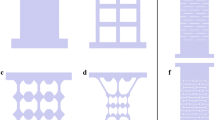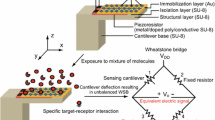Abstract
In this paper, we devise an approach for material selection of constituent layers of a composite piezoresistive cantilever sensor using Ashby’s methodology. A rational choice of the constituent materials of a piezoresistive cantilever sensor becomes critical not only due to its multi-layered hetero structure but also due to the interdependence of material properties and geometrical parameters in governing its performance and reliability. Material selection is performed by identifying the performance metrics that govern the sensor performance and depict the interplay between the material constants and geometrical parameters. Here, apart from considering the coupled effects of electro-mechanical parameters we have also incorporated the impact of joule heating induced self-heating effects in the material selection process. Further, the material selection process is validated by computing the performance metrics of different sensors with same resonant frequency using analytical models. Results show that a silicon cantilever with a doped p-type piezoresistor, a silicon dioxide isolation layer and a gold immobilization layer is relatively better considering performance characteristics and reliability as compared to an SU-8 polymeric and other solid-state semiconductor based piezoresistive cantilever surface stress sensors, especially when joule heating induced inaccuracy is taken into account.






Similar content being viewed by others
References
Alpuim P, Chu V, Conde JP (2002) Piezoresistive sensors on plastic substrates using doped microcrystalline silicon. IEEE Sens J 2:336–341
Ansari MZ, Cho C (2012) A conduction–convection model for self-heating in Piezoresistive microcantilever biosensors. Sens Actuators A 175:19–27
Ashby MF (1992) Material selection in mechanical design, 1st edn. Pergamon press, Oxford
Bonthu MK, Sharma AK (2018) An investigation of dielectric material selection of RF-MEMS switches using Ashby’s methodology for RF applications. Microsyst Technol 24(4):1803–1809
Chiamori HC, Brown JW, Adhiprakasha EV, Hantsoo ET, Straalsund JB, Melosh NA, Pruitt BL (2008) Suspension of nanoparticles in SU-8: Processing and characterization of nanocomposite polymers. Microelectron J 39:228–236
Chui BW, Aeschimann L, Akiyama T, Staufer U, de Rooij NF (2007) Advanced temperature compensation for piezoresistive sensors based on crystallographic orientation. Rev Sci Instrum 78:043706
Fernandez RE, Stolyarova S, Chadha A, Bhattacharya E, Nemirovsky Y (2009) MEMS composite porous silicon/polysilicon cantilever sensor for enhanced triglycerides biosensing. IEEE Sens J 9:1660–1666
Geisberger AA, Sarkar N, Matthew E, Skidmore GD (2003) Electrothermal properties and modeling of polysilicon microthermal actuators. J Microelectromech Syst 12:513–523
Gupta N, Ashwin R (2018) Material selection methodology for radio frequency (RF) microelectromechanical (MEMS) capacitive shunt switch. Microsyst Technol. https://doi.org/10.1007/s00542-018-3761-1
Harley JA, Kenny TW (2000) 1/f noise considerations for the design and process optimization of piezoresistive cantilevers. J Microelectromech Syst 9:226–235
Hooge FN (1969) 1/f noise is no surface effect. Phys Lett A 29:139–140
Hopcroft MA, Nix WD, Kenny TW (2010) What is the Young’s modulus of silicon. J Microelectromech Syst 19:229–238
Jiguet S, Bertsch A, Hofmann H, Renaud P (2004) SU-8 silver photosensitive nanocomposite. Adv Eng Mater 6:719–724
Johansson A, Hansen O, Hales J, Boisen A (2006) Temperature effects in Au piezoresistors integrated in SU-8 cantilever chips. J Micromech Microeng 16:2564–2569
Kale NS, Nag S, Pinto R, Rao VR (2009) Fabrication and characterization of polymeric microcantilever with encapsulated hotwire CVD polysilicon piezoresistor. J Microelectromech Syst 18:79–87
Kandpal M, Adami A, Giacomozzi F, Zen M, Rao VR, Lorenzelli L (2017) Theoretical and experimental analysis of residual stress mitigation in piezoresistive silicon nitride cantilever. In: AISEM annual conference on sensors and microsystems, pp 229–235
Katada A, Buys YF, Tominaga Y, Asai S, Sumita M (2005) Resistivity control in the semiconductive region for carbon-black-filled polymer composites Colliod Polymer. Science 283:367–374
Khemthongcharoen N, Wonglumsom W, Suppat A, Jaruwongrungsee K, Tuantranont A, Promptmas C (2015) Piezoresistive microcantilever-based DNA sensor for sensitive detection of pathogenic Vibrio cholerae O1 in food sample. Biosens Bioelectron 15:347–353
Lee J, Goericke F, King WP (2008) Temperature-dependent thermomechanical noise spectra of doped silicon microcantilevers. Sens Actuators A 145:37–43
Liu HY, Li WH, Zhou ZF, Huang QA (2014) In-situ determination of the coefficient of thermal expansion of polysilicon thin films using micro-rotating structures. Thin Solid Films 552:184–191
Loui A, Goericke FT, Ratto TV, Lee J, Hart BR, King WP (2008) The effect of piezoresistive microcantilever geometry on the cantilever sensitivity during surface stress chemical sensing. Sens Actuator A 147:516–521
Love JC, Estroff LA, Kriebel JK, Nuzzo RG, Whitesides GM (2005) Self-assembled monolayers of thiolates on metals as a form of nanotechnology. Chem Rev 105:1103–1169
Mathew R, Sankar AR (2015) Design of a triangular platform piezoresistive affinity microcantilever sensor for biochemical sensing applications. J Phys D Appl Phys 48:205402
Mathew R, Sankar AR (2016) Numerical study on the influence of buried oxide layer of SOI wafers on the terminal characteristics of a micro/nano cantilever biosensor with an integrated piezoresistor. Biomed Phys Eng Express 2:055012
Mathew R, Sankar AR (2017) silico modeling and investigation of self-heating effects in composite nano cantilever biosensors with integrated piezoresistors. AIP Adv 7:035108
Mathew R, Sankar AR (2018a) A review on surface stress-based miniaturized piezoresistive SU-8 polymeric cantilever. Sens Nano Micro Lett 1:35
Mathew R, Sankar AR (2018b) Piezoresistive composite silicon dioxide nanocantilever surface stress sensor: design and optimization. J Nanosci Nanotechnol 18:3387–3397
McConnell AD, Uma S, Goodson KE (2001) Thermal conductivity of doped polysilicon layers. J Microelectromech Syst 10:360–369
Rasmussen PA, Thaysen J, Hansen O, Eriksen SC, Boisen A (2003) Optimised cantilever biosensor with piezoresistive read-out. Ultramicroscopy 97:371–376
Sassolas A, Blum LJ, Bouvier BDL (2012) Immobilization strategies to develop enzymatic biosensors. Biotechnol Adv 30:489–511
Srikar VT, Spearing SM (2003) Material selection for microfabricated electrostatic actuators. Sens Actuators A 102:279–285
Tan ZO, Zhang NH, Meng WL, Tang HS (2016) Mechanism for invalid detection of microcantilever-DNA biosensors due to environmental changes. J Phys D Appl Phys 49:225402
Thaysen J, Yalcinkaya AD, Vettiger P, Menon A (2002) Polymer based stress sensor with integrated readout. J Phys D Appl Phys 35:2698–2703
Wang Z, Yue R, Zhang R, Liu L (2005) Design and optimization of laminated piezoresistive microcantilever sensors. Sens Actuators A 120:325–336
Wee KW, Kang GY, Park J, Kang JY, Yoon DS, Park JH, Kim TS (2005) Novel electrical detection of label-free disease marker proteins using piezoresistive self-sensing microcantilever. Biosens Bioelectron 20:1932–1938
Wouters K, Puers R (2010) Diffusing. and swelling in SU-8: insight in material properties and processing. J Micromech Microeng 20:095013
Yang SM, Yin TI, Chang C (2007) A biosensor chip by CMOS process for surface stress measurement in bioanalyte. Sens Actuators B 123:707–714
Yang SM, Chang C, Yin TI, Kuo PL (2008) DNA hybridization measurement by self-sensing piezoresistive microcantilevers in CMOS biosensor. Sens Actuators B Chem 130:674–681
Yang Y, Chen Y, Xu P, Li X (2010) Quad-cantilever microsensors with a low cost single-sided micro-machining technique for trace chemical vapor detection. Microelectron Eng 87:2317–2322
Yang T, Li X, Chen Y, Lee DW, Zuo G (2011) Adsorption induced surface-stress sensing signal originating from both vertical interface effects and intermolecular lateral interactions. Analyst 136:5261–5269
Zhang N, Xie J, Guers M, Varadan VK (2003) Chemical bonding multiwalled carbon nanotube to SU-8 via ultrasonic irradiation. Smart Mater Struct 12:260
Zhou Y, Wang Z, Zhang Q, Ruan W, Liu L (2009) A front-side released single crystalline silicon piezoresistive microcantilever sensor. IEEE Sens J 9:246–254
Acknowledgements
This work was supported by the Science and Engineering Research Board (SERB), Department of Science and Technology (DST), Government of India under the Extramural Research (EMR) Grant no. SB/S3/EECE/076/2016.
Author information
Authors and Affiliations
Corresponding author
Additional information
Publisher's Note
Springer Nature remains neutral with regard to jurisdictional claims in published maps and institutional affiliations.
Rights and permissions
About this article
Cite this article
Mathew, R., Sankar, A.R. Temperature drift-aware material selection of composite piezoresistive micro-cantilevers using Ashby’s methodology. Microsyst Technol 27, 2647–2660 (2021). https://doi.org/10.1007/s00542-020-05013-2
Received:
Accepted:
Published:
Issue Date:
DOI: https://doi.org/10.1007/s00542-020-05013-2




